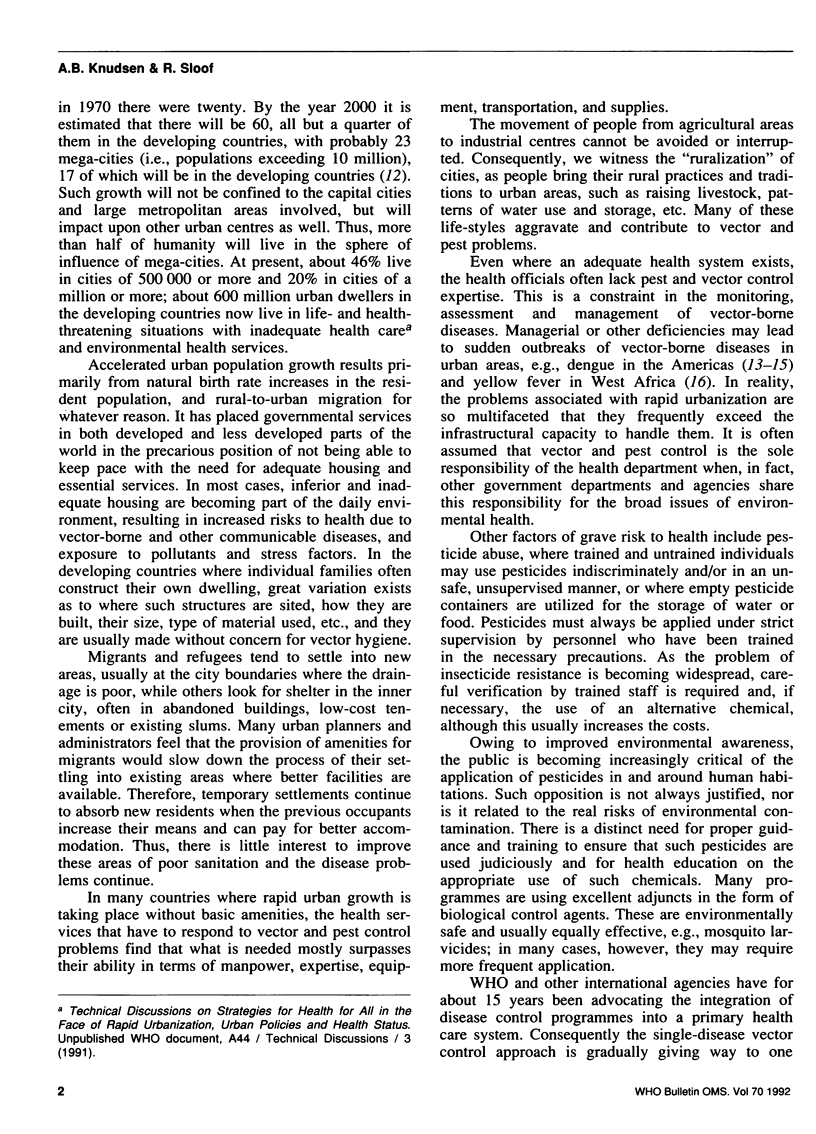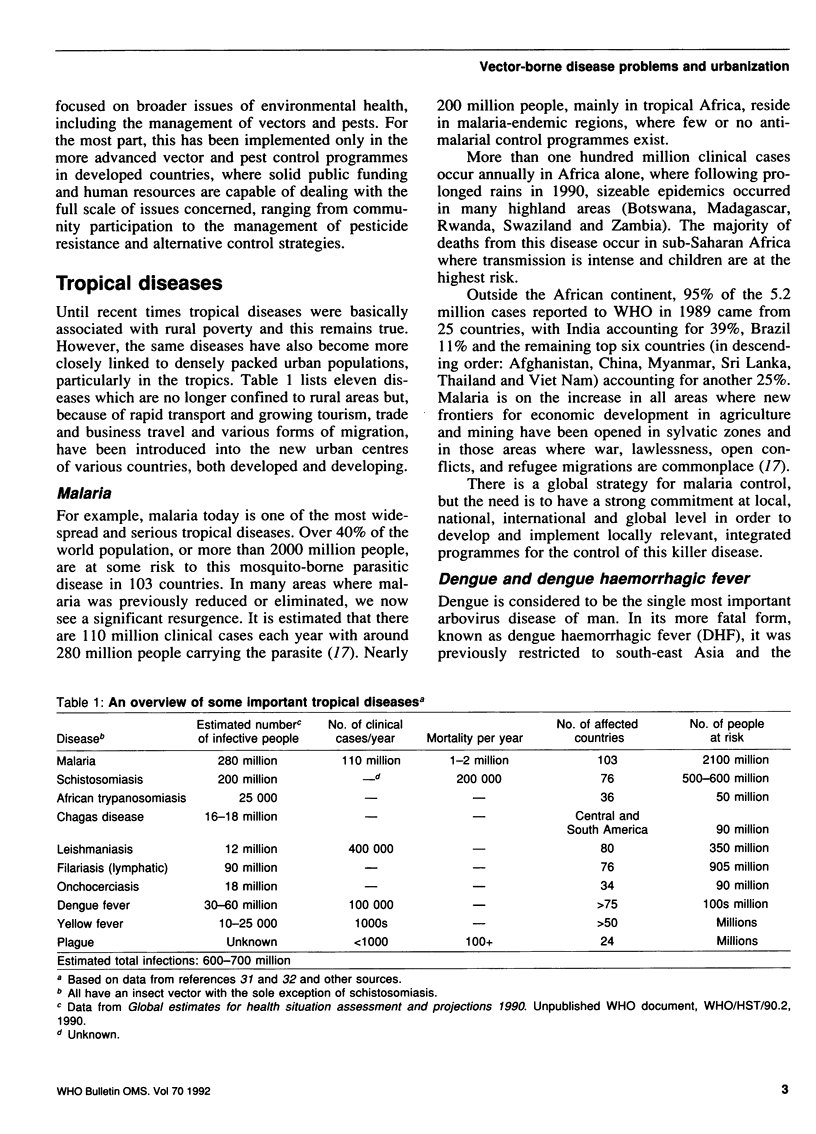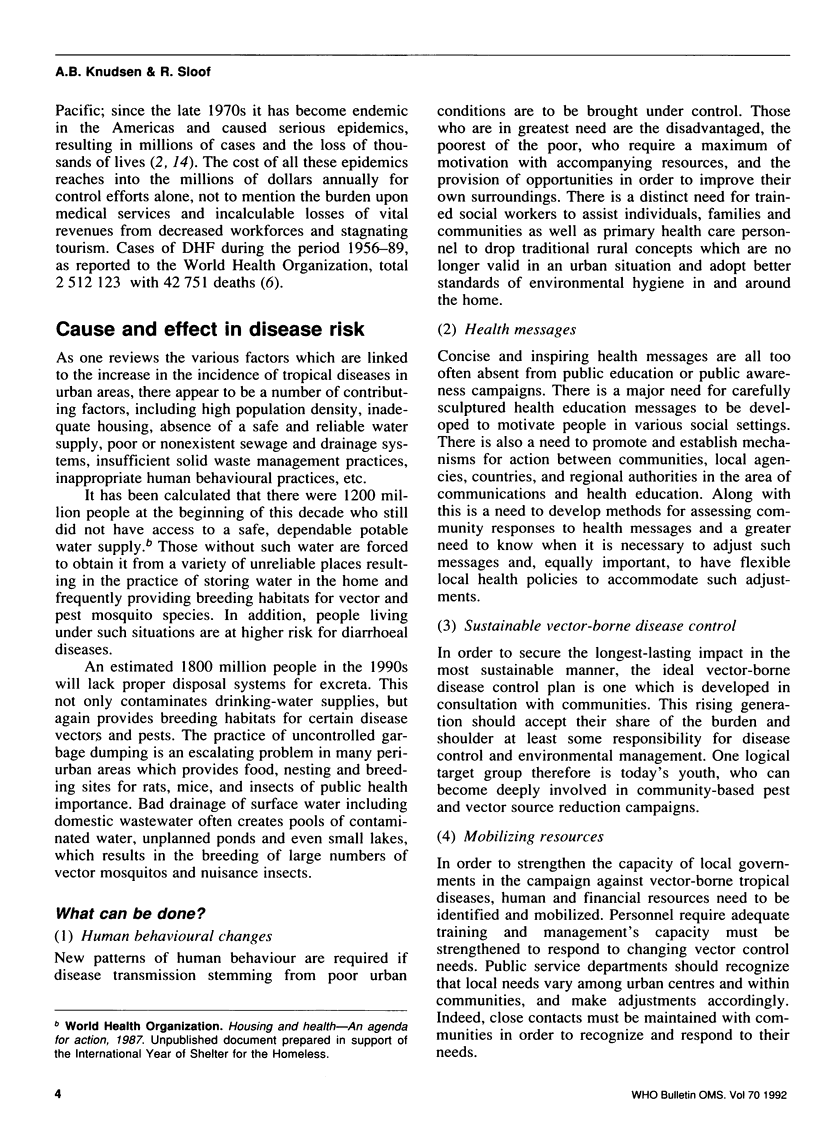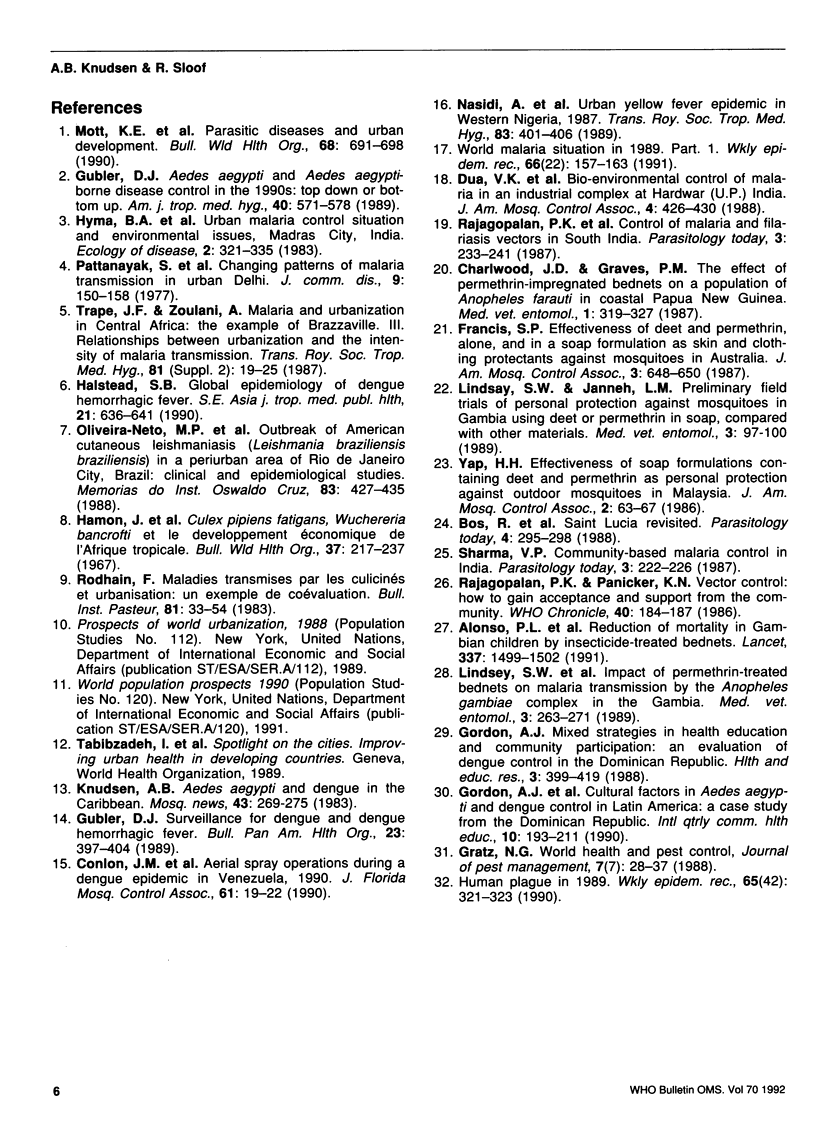Abstract
Owing to population growth, poor levels of hygiene, and increasing urban poverty, the urban environment in many developing countries is rapidly deteriorating. Densely packed housing in shanty towns or slums and inadequate drinking-water supplies, garbage collection services, and surface-water drainage systems combine to create favourable habitats for the proliferation of vectors and reservoirs of communicable diseases. As a consequence, vector-borne diseases such as malaria, lymphatic filariasis and dengue are becoming major public health problems associated with rapid urbanization in many tropical countries. The problems in controlling these diseases and eliminating vectors and pests can be resolved by decision-makers and urban planners by moving away from the concept of "blanket" applications of pesticides towards integrated approaches. Sound environmental management practices and community education and participation form the mainstay of some of the most outstanding successes in this area. On the basis of these examples, it is argued that the municipal authorities need to apply a flexible methodology, which must be based on the possibilities of mobilizing community resources, with minimal reliance on routine pesticidal spraying. In this way, vector control becomes a by-product of human development in the city environment. This is now a true challenge.
Full text
PDF





Selected References
These references are in PubMed. This may not be the complete list of references from this article.
- Alonso P. L., Lindsay S. W., Armstrong J. R., Conteh M., Hill A. G., David P. H., Fegan G., de Francisco A., Hall A. J., Shenton F. C. The effect of insecticide-treated bed nets on mortality of Gambian children. Lancet. 1991 Jun 22;337(8756):1499–1502. doi: 10.1016/0140-6736(91)93194-e. [DOI] [PubMed] [Google Scholar]
- Bos R., Février M., Knudsen A. B. Saint Lucia revisited. Parasitol Today. 1988 Oct;4(10):295–298. doi: 10.1016/0169-4758(88)90029-4. [DOI] [PubMed] [Google Scholar]
- Charlwood J. D., Graves P. M. The effect of permethrin-impregnated bednets on a population of Anopheles farauti in coastal Papua New Guinea. Med Vet Entomol. 1987 Jul;1(3):319–327. doi: 10.1111/j.1365-2915.1987.tb00361.x. [DOI] [PubMed] [Google Scholar]
- Dua V. K., Sharma V. P., Sharma S. K. Bio-environmental control of malaria in an industrial complex at Hardwar (U.P.), India. J Am Mosq Control Assoc. 1988 Dec;4(4):426–430. [PubMed] [Google Scholar]
- Gubler D. J. Aedes aegypti and Aedes aegypti-borne disease control in the 1990s: top down or bottom up. Charles Franklin Craig Lecture. Am J Trop Med Hyg. 1989 Jun;40(6):571–578. doi: 10.4269/ajtmh.1989.40.571. [DOI] [PubMed] [Google Scholar]
- Gubler D. J. Surveillance for dengue and dengue hemorrhagic fever. Bull Pan Am Health Organ. 1989;23(4):397–404. [PubMed] [Google Scholar]
- Halstead S. B. Global epidemiology of dengue hemorrhagic fever. Southeast Asian J Trop Med Public Health. 1990 Dec;21(4):636–641. [PubMed] [Google Scholar]
- Hamon J., Burnett G. F., Adam J. P., Rickenbach A., Grjebine A. Culex pipiens fatigans Wiedemann, Wuchereria bancrofti Cobbold, et le développement économique de l'Afrique tropicale. Bull World Health Organ. 1967;37(2):217–237. [PMC free article] [PubMed] [Google Scholar]
- Hyma B., Ramesh A., Chakrapani K. P. Urban malaria control situation and environmental issues, Madras City, India. Ecol Dis. 1983;2(4):321–335. [PubMed] [Google Scholar]
- Lindsay S. W., Janneh L. M. Preliminary field trials of personal protection against mosquitoes in The Gambia using deet or permethrin in soap, compared with other methods. Med Vet Entomol. 1989 Jan;3(1):97–100. doi: 10.1111/j.1365-2915.1989.tb00481.x. [DOI] [PubMed] [Google Scholar]
- Mott K. E., Desjeux P., Moncayo A., Ranque P., de Raadt P. Parasitic diseases and urban development. Bull World Health Organ. 1990;68(6):691–698. [PMC free article] [PubMed] [Google Scholar]
- Nasidi A., Monath T. P., DeCock K., Tomori O., Cordellier R., Olaleye O. D., Harry T. O., Adeniyi J. A., Sorungbe A. O., Ajose-Coker A. O. Urban yellow fever epidemic in western Nigeria, 1987. Trans R Soc Trop Med Hyg. 1989 May-Jun;83(3):401–406. doi: 10.1016/0035-9203(89)90518-x. [DOI] [PubMed] [Google Scholar]
- Oliveira-Neto M. P., Pirmez C., Rangel E., Schubach A., Grimaldi Júnior G. An outbreak of American cutaneous leishmaniasis (Leishmania braziliensis braziliensis) in a periurban area of Rio de Janeiro city, Brazil: clinical and epidemiological studies. Mem Inst Oswaldo Cruz. 1988 Oct-Dec;83(4):427–435. doi: 10.1590/s0074-02761988000400006. [DOI] [PubMed] [Google Scholar]
- Rajagopalan P. K., Panicker K. N., Das P. K. Control of malaria and filariasis vectors in South India. Parasitol Today. 1987 Aug;3(8):233–241. doi: 10.1016/0169-4758(87)90146-3. [DOI] [PubMed] [Google Scholar]
- Rajagopalan P. K., Panicker K. N. Vector control: how to gain acceptance and support from the community. WHO Chron. 1986;40(5):184–187. [PubMed] [Google Scholar]
- Sharma V. P. Community-based malaria control in India. Parasitol Today. 1987 Jul;3(7):222–226. doi: 10.1016/0169-4758(87)90066-4. [DOI] [PubMed] [Google Scholar]
- Trape J. F., Zoulani A. Malaria and urbanization in central Africa: the example of Brazzaville. Part III: Relationships between urbanization and the intensity of malaria transmission. Trans R Soc Trop Med Hyg. 1987;81 (Suppl 2):19–25. doi: 10.1016/0035-9203(87)90473-1. [DOI] [PubMed] [Google Scholar]
- Yap H. H. Effectiveness of soap formulations containing deet and permethrin as personal protection against outdoor mosquitoes in Malaysia. J Am Mosq Control Assoc. 1986 Mar;2(1):63–67. [PubMed] [Google Scholar]


